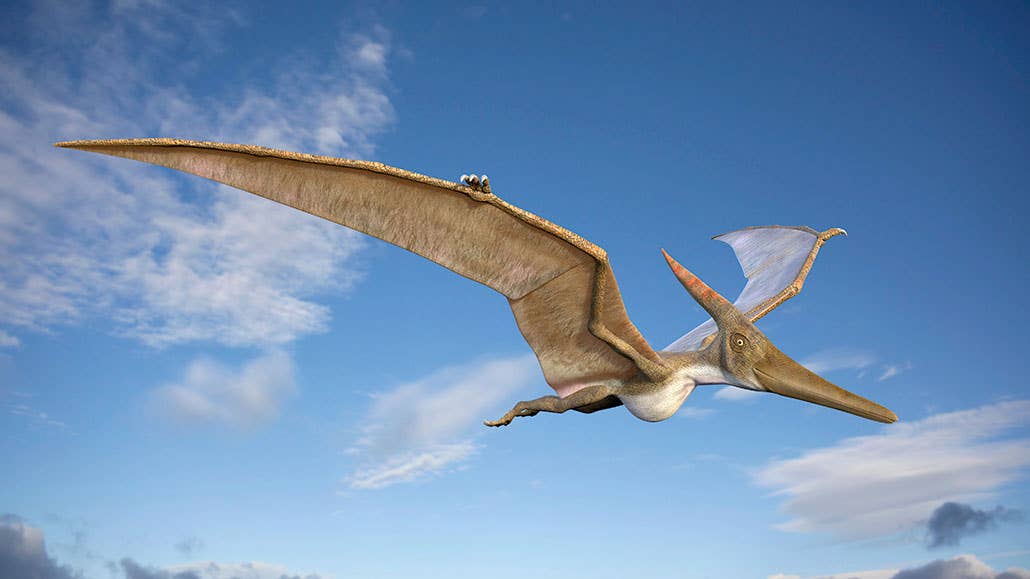Breakthrough discovery ends the debate on how Pterosaurs flew
CT scans of rare pterosaur fossils reveal distinct flight adaptations, providing new insights into the soaring and flapping styles of ancient reptiles.

Rare fossils from Jordan reveal the flight mechanics of ancient pterosaurs. CT scans show contrasting adaptations for soaring and flapping flight styles. (CREDIT: Getty Images)
Pterosaurs were the first vertebrates to achieve powered flight, but they remain the only major volant group to face extinction. Despite their significance, much about their flight mechanics has been elusive due to the rarity of well-preserved fossils. Recent discoveries in Jordan, however, have shed light on this mystery, offering new insights into the flight styles of these ancient reptiles.
Two large-bodied azhdarchoid pterosaur fossils, dated to the Late Cretaceous period, were unearthed from the Afro-Arabian region. One fossil represents the known species Arambourgiania philadelphiae, which boasted a wingspan of 10 meters.
The second is a newly identified species, Inabtanin alarabia, with a wingspan of 5 meters. High-resolution micro-computed tomography (CT) scans were used to analyze the internal structure of their flight bones, revealing distinct adaptations linked to their flight styles.
The bone structure of Arambourgiania features spiral ridges within its hollow humerus. These ridges closely resemble those found in the wing bones of modern vultures, which are optimized for soaring flight. Such structural adaptations suggest that Arambourgiania was adept at gliding over long distances, relying on minimal energy expenditure during sustained flight.
In contrast, the bones of Inabtanin exhibited a dense pattern of struts, similar to those seen in flapping birds. These features are adapted to withstand the bending forces associated with flapping flight. This indicates that Inabtanin primarily employed flapping as its main mode of locomotion, though it may have occasionally soared as well.
Dr. Kierstin Rosenbach of the University of Michigan, the lead author of the study, emphasized the rarity of such well-preserved fossils. “Since pterosaur bones are hollow and fragile, they are often flattened or damaged. Published in the Journal of Vertebrate Paleontology, The discovery of three-dimensionally preserved pterosaur bones is exceptional,” she explained.
The CT scans revealed “exciting internal structures” that were both preserved and visible, allowing researchers to glean unprecedented insights into the flight mechanics of these creatures.
The discovery also challenges previous debates regarding the flight capabilities of giant pterosaurs. For years, paleontologists questioned whether large species like Arambourgiania could even achieve flight. The findings suggest that not only could these giants fly, but their flight styles varied significantly based on their anatomy and ecological needs.
Related Stories
The implications extend beyond mere classification. Understanding the flight mechanics of pterosaurs provides a window into their behavior and ecological roles. The contrasting adaptations between soaring and flapping reflect different environmental pressures and lifestyles.
Arambourgiania’s soaring capabilities suggest a life spent traversing vast open areas, possibly over oceans, while Inabtanin’s flapping flight indicates maneuverability suited to more constrained or dynamic environments.
Dr. Rosenbach noted that flapping is likely the ancestral flight style among flying vertebrates. “Even birds that soar or glide require some flapping to achieve and maintain flight,” she explained. This suggests that flapping may have been the default condition for early pterosaurs, with soaring evolving later as a specialized adaptation to specific ecological niches.
The discoveries also highlight the importance of Afro-Arabia as a region for paleontological research. The fossils, preserved in nearshore sediments, provide valuable context for understanding the diversity and evolution of pterosaurs in this ancient landmass.
Co-author Professor Jeff Wilson Mantilla from the University of Michigan’s Museum of Paleontology remarked on the significance of these variations, stating, “The differences likely reflect responses to mechanical forces experienced during flight.”
These findings also open new avenues for the study of vertebrate flight. By comparing the internal bone structures of pterosaurs with those of modern birds, scientists can better understand how flight mechanics evolved over millions of years. Dr. Rosenbach expressed hope that this research will inspire further investigation into the relationship between bone structure and flight behavior in extinct and extant species.
Adding to the intrigue of these discoveries is the broader context of pterosaur diversity during the Cretaceous period. The latest Cretaceous was a dynamic time in Earth's history, marked by shifting continents, fluctuating sea levels, and the emergence of new ecological niches.
The presence of both soaring and flapping pterosaurs in this region indicates a complex ecosystem where different flight styles likely played critical roles in resource acquisition, predator avoidance, and migration.
The research team’s use of advanced imaging technologies like CT scanning underscores the importance of modern tools in paleontology. Traditional methods often fall short when dealing with fragile, hollow fossils like those of pterosaurs. By leveraging these technologies, scientists can visualize and analyze structures that would otherwise remain hidden, enhancing our understanding of extinct species.
The naming of the new species, Inabtanin alarabia, reflects a deep connection to the discovery site. The name combines Arabic words for "grape" and "dragon," inspired by the nearby grape-colored hill, Tal Inab. The inclusion of “alarabia” pays homage to the Arabian Peninsula, emphasizing the regional significance of this find.
Dr. Iyad Zalmout of the Saudi Geological Survey, a co-author of the study, highlighted the collaborative nature of the research. The partnership between institutions in Jordan, Saudi Arabia, and the United States exemplifies the global effort required to uncover and study such rare fossils. “This discovery would not have been possible without the combined expertise and resources of our international team,” he stated.
The broader implications of this research extend to the understanding of flight evolution in vertebrates. Pterosaurs were not only pioneers of powered flight but also exemplified the diversity of adaptations that can arise in response to environmental challenges. Their extinction, coinciding with the end-Cretaceous mass extinction event, underscores the fragility of even the most successful evolutionary innovations.
Future research will likely build on these findings, exploring how variations in bone structure correlate with other aspects of pterosaur biology, such as muscle attachment, wing membrane dynamics, and energy efficiency. Such studies could also inform bio-inspired designs in modern aeronautics, drawing parallels between ancient flight mechanics and contemporary engineering challenges.
Pterosaurs remain a testament to the evolutionary ingenuity of life on Earth. As the earliest vertebrates to conquer the skies, they laid the groundwork for the complex flight adaptations seen in modern birds and bats.
The discoveries from Jordan not only illuminate their past but also enrich our understanding of the mechanics and diversity of powered flight, reminding us of the intricate interplay between form, function, and environment in shaping the natural world.
Note: Materials provided above by The Brighter Side of News. Content may be edited for style and length.
Like these kind of feel good stories? Get The Brighter Side of News' newsletter.



